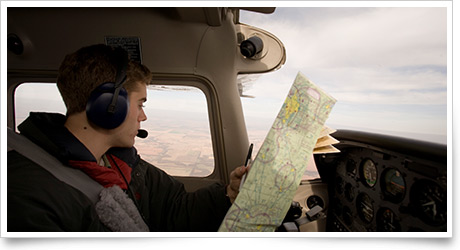| The following stories from the May 18, 2012, edition of AOPA ePilot were provided to AOPA members who expressed an interest in the particular subject areas. Any AOPA member can receive information tailored to their areas of interest by updating their preferences online |
training tipsGo on, get lost Avoiding scenarios like that is an everyday concern for pilots of basic or modestly equipped aircraft, even if the possibility may strike many digital-age pilots as remote. But throw in a little complacency, an electrical problem, and some weather, and suddenly your pilotage skills could be put to the test. How would you fare? Here’s a way to find out: Get “lost.” Not with the risks—think obstruction hazards or airspace incursions—that you could face under adverse conditions. Make re-establishing exact knowledge of your position a controlled experiment that tests the skills needed to cope with the real thing. This is not a hard experiment to set up safely and effectively with your instructor aboard as facilitator and safety pilot. During a cross-country diversion exercise, descend to a safely low altitude and establish your exact position en route to the alternate airport using visual checkpoints, estimated groundspeed, and track. You can test the same skills as the immediate follow-up to a period of dual practice of flight by reference to instruments (during which you have not been permitted to look outside for a while). Stumped as to your whereabouts? Then you must decide on an “appropriate course of action,” as called for in the Private Pilot Practical Test Standards (PTS), and subject to the flight conditions your CFI has imposed for the drill. Getting un-lost doesn’t have to be a visual-references-only process. Leaving the GPS switched off, see if you can determine your position using intersecting radials from two VORs—in essence, creating your own waypoint. Be sure to verify your findings using a visual checkpoint that should now be visible from your probable position. Find more tips in the Air Safety Institute Emergency Operations Webinar. Speaking of the PTS, it’s not just for tests. The Flight Training Checkride column reminded pilots that “the FAA, Congress, your insurance carrier, your passengers, and anyone else who has an interest in how safely you fly expects you to fly per the PTS.” That could mean being having to do things the old-fashioned way someday. training productsStratus portable in-flight weather receiverSporty’s is taking orders for the Appareo Stratus receiver that streams in-flight weather to Foreflight and can be displayed on an iPad. The unit provides NEXRAD radar, METARs, terminal aerodrome forecasts, pilot reports, temporary flight restrictions, and more information, and does not require a monthly subscription to obtain the data. The unit sells for $799. The estimated ship date on orders is May 30. Order online or call 800/776-7897.
Note: Products listed have not been evaluated by ePilot editors unless otherwise noted. AOPA assumes no responsibility for products or services listed or for claims or actions by manufacturers or vendors. final examQuestion: If I provide flight instruction in my airplane, would it have to undergo 100-hour inspections?
Answer: Yes. According to Federal Aviation Regulation 91.409(b), “…no person may give flight instruction in an aircraft which that person provides, unless within the preceding 100 hours of time in service the aircraft has received an annual or 100-hour inspection and been approved for return to service in accordance with part 43 of this chapter or has received an inspection for the issuance of an airworthiness certificate in accordance with part 21 of this chapter.” For more information on required aircraft inspections please see AOPA’s subject report.
Got a question for our technical services staff? Email [email protected] or call the Pilot Information Center, 800/872-2672. Don’t forget the online archive of “Final Exam” questions and answers, searchable by keyword or topic. |
 The clouds are lower, and visibility is failing. Fuel isn’t a problem yet, but time is ticking. Were it only a little easier to see, you could spot a landmark, reorient yourself, and find the way home. Somewhere out there is a 1,500-foot-high peak, and numerous towers …
The clouds are lower, and visibility is failing. Fuel isn’t a problem yet, but time is ticking. Were it only a little easier to see, you could spot a landmark, reorient yourself, and find the way home. Somewhere out there is a 1,500-foot-high peak, and numerous towers …

